Dell XPS One 27 Review: The Premium All-in-One
by Dustin Sklavos on May 29, 2012 9:00 AM EST- Posted in
- Systems
- Dell
- Intel
- XPS
- Ivy Bridge
- Kepler
- all-in-one
- 600M
- NVIDIA
System Performance
Ivy Bridge is a very strange beast. It's been generally underwhelming for enthusiasts given the middling overclocking headroom stemming from poor thermals, though my experience with it is that you can hit roughly the same overall performance levels as Sandy Bridge at lower clocks and lower power consumption. Where Intel's new chips were born to succeed are laptops and all-in-ones, and I think Dell's XPS One is going to be a solid proof of that.
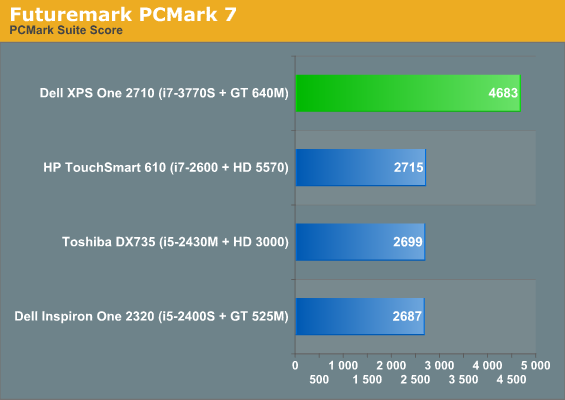
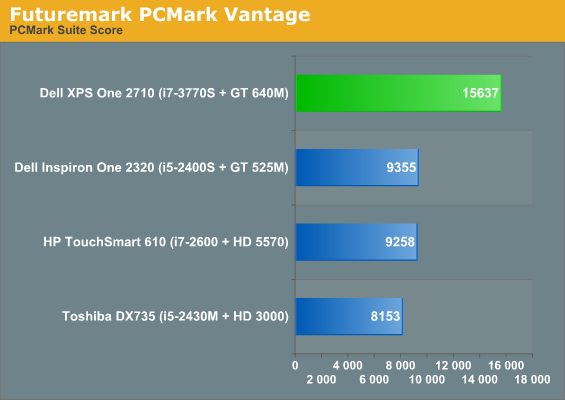
The PCMarks skew heavily towards the SSD caching technology in Dell's XPS One, but the system also features the fastest CPU and fastest graphics of any of the all-in-ones we've tested. Advances in process technology may allow the top end to edge up, but in thermally constrained spaces they can result in big, big performance gains.
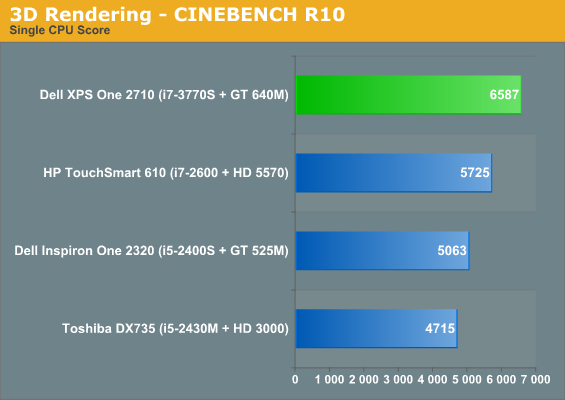
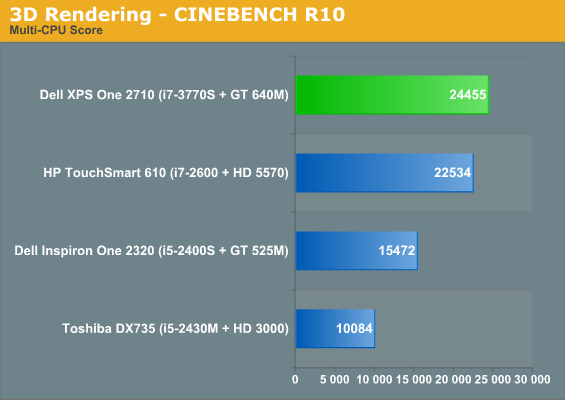
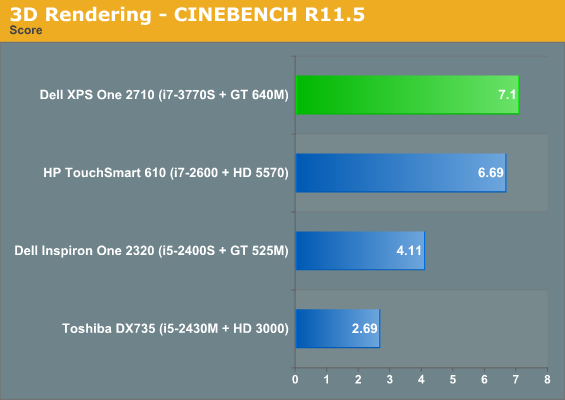
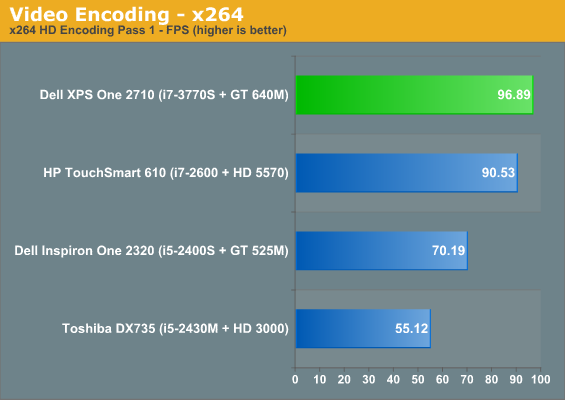
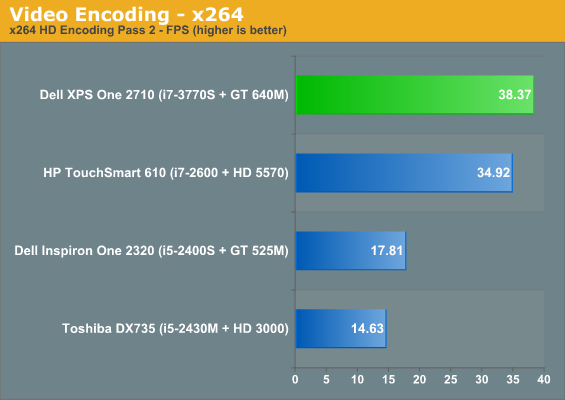
Intel's Core i7-3770S allows Dell's XPS One to soundly beat last generation's top 95W processor (outside of the i7-2700K), but the 3770S chops off a third of the i7-2600's TDP. Performance is up across the board, allowing the XPS One to offer a tremendous amount of power for what's fundamentally a family appliance.
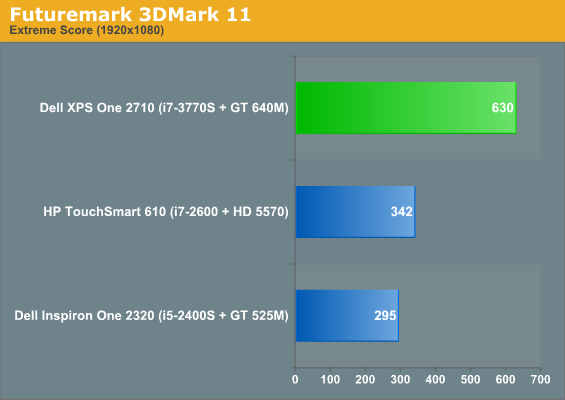
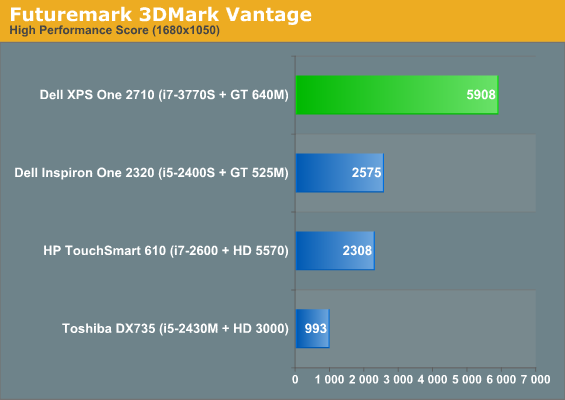
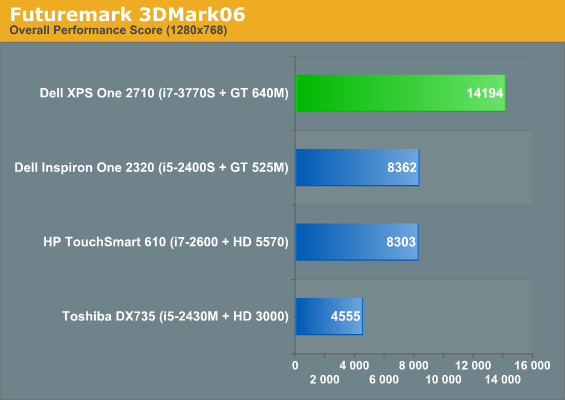
The GDDR5 on the GeForce GT 640M also allows the GPU in the XPS One to stretch its legs, delivering at least twice as much graphics performance as the last generation all-in-one from Dell. At this point I'm convinced going with anything but GDDR5 on all-in-one graphics hardware is unacceptable; either stick with the IGP or go all in. Power consumption isn't as big of an issue with all-in-ones, and the bandwidth afforded by GDDR5 is essential for providing a decent gaming experience at 1080p.
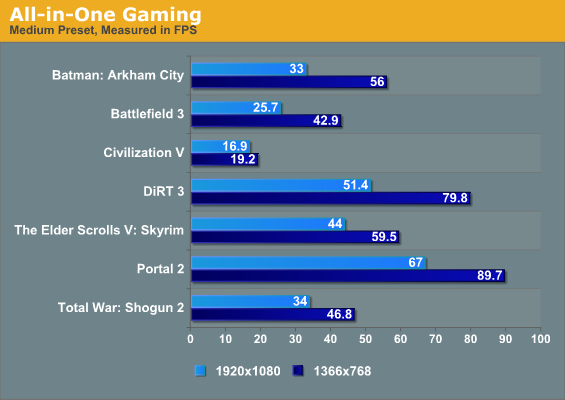
Since the other all-in-ones were benchmarked using our old gaming suite, we only have results for the Dell XPS One 2710. That said, generally speaking it has the chops to game at 1080p. I wouldn't push it to the panel's native resolution of 2560x1440, but you can still have a decent gaming experience on the XPS One. This is a massive improvement over the previous generation. And for those who might otherwise complain about not gaming at native resolution, remember that 2560x1440 on a 27" panel gives a small enough dot pitch that running non-native isn't quite as disctracting as on lesser LCDs.










69 Comments
View All Comments
lurker22 - Tuesday, May 29, 2012 - link
Just buy an iMac. Dell continues to be lousy engineering.lowlymarine - Tuesday, May 29, 2012 - link
Well, I'd say at least wait for the IVB refresh of the iMacs (which should land inside a month or so). When that happens, the prices on these will have to com down; they're barely competitive with the current-generation iMacs as it is.Also, remember when Apple used to be the company using hilariously anemic GPUs in their computers while everyone else had higher-end chips available? When did that table turn? A 640M as the highest-end option in a 27" AIO, with the XPS branding no less, while Apple offers a 6970M in last years model? Ridiculous.
tipoo - Tuesday, May 29, 2012 - link
I would have to agree, the iMac seems like a downright great value now that other companies are trying to target the same range. And if it gets upgraded to retina displays this next refresh...JarredWalton - Tuesday, May 29, 2012 - link
Look at the pricing on a 27" iMac with an i7 CPU, 8GB RAM, 2TB HDD, SSD caching and Blu-ray (they don't offer these two options, actually), and a 6970M before you hand Apple the crown for AIOs. If you're looking purely at the GPU, Apple wins. If you're looking at the overall design and aesthetic, I'd call it a toss up, but I'd assume the Apple 27" iMac is able to cool the CPU+GPU better so we'll give Apple another win. And then you get to the price.It looks like a comparable current-gen iMac 27" with a better GPU will run you $2550 online at B&H, and you still lose Blu-ray capability and the SSD caching. I'm not sure if Apple will support Intel's SSD caching with the next generation iMac either -- Apple has been pretty careful about what new techs they support, particularly in the SSD realm. And of course the bottom line is that if you don't like OS X, you'd be crazy to purchase a Mac of any form. I know plenty of people that like OS X, but I know just as many that hate it; I happen to fall into the latter camp.
Still, it boggles the mind that Dell couldn't just have a second HSF cooling the CPU in the 2710 to fix the temperature issues.
Penti - Tuesday, May 29, 2012 - link
You could always install 16 GB SO-DIMM DDR3 plus 128GB Samsung SSD for like 260 USD if you care to do the upgrade. As it might not be straight forward. An external Blu-ray drive costs you 70-100 USD and a Windows retail license of W7HP costs you some 170 USD. That would enable you everything including blu-ray playback. Might be a 600 - 700 USD upgrade though. Just installing ram though costs you 32 USD and requires no disassembly. A 2TB drive is 150 USD though if you don't want to disassemble the case. The i7 is 200 USD addon too, and not Ivy yet. If graphics isn't that important I would go with the HP Z1 Workstation though.On a system with mSATA the upgrade would obviously be to install a 128/256GB mSATA SSD. Not some Intel RST feature. It's just Intel Windows driver software any way.
Not that Dell here isn't unusably reasonable in it's configure. We mostly see 20-23" low end machines around 1000 dollars with TN displays otherwise. But they don't seem to have taken the build seriously restricting themselves to slightly low power cpus. I guess using a 3770k would have speed up things a bit.
protomech - Tuesday, May 29, 2012 - link
"Also, remember when Apple used to be the company using hilariously anemic GPUs in their computers while everyone else had higher-end chips available?"No. I bought an ibook back in 2002 because it had a 100 mhz bus G3 and a mobility radeon 16 MB. Contemporary PC laptops were either integrated graphics (i810 chipset) or a slightly larger form factor with discrete graphics and lower battery life.
While the powerbook titanium / aluminum line never really had high-powered discrete graphics .. they offered basically the best GPUs that could fit in their 1" form factor. Charged an arm and a leg for it too..
Excepting a brief period in 2006-2007 (mac mini and macbook with intel GMA 950), Apple has typically used a pretty high base level of graphics hardware in their systems. They've only rarely offered truly excellent graphics options (6970M in current iMac is a big exception), but by offering a high baseline they've been able to build their operating systems with a minimum level of guaranteed graphics performance.
Perhaps not unexpectedly, the iPhone / iPad lineup has always offered some of the best graphics available among contemporary smartphones.
Dustin Sklavos - Wednesday, May 30, 2012 - link
Think the Mac towers. For a long time, the bottom rung configuration of systems that have almost always started at a brutal $2,499 almost always included what seemed like the worst dedicated GPU they could find.AssBall - Wednesday, May 30, 2012 - link
That still doesn't present a good argument from a reasonable perspective. You don't need a high powered gpu in an i-mac, because you aren't going to run any software that stresses it. imacs and aio in general are for the fung-shui crowds. A lesser gpu in a 27" will run games fine at max with a good subsystem. Gamers don't buy imacs, or any macs, for gaming. They are a nice piece of usefull furniture but nobody should pretend they aren't a luxury item. The rest of us will sb happy to settle for an upgradable, cheaper, run of the mill pc with more versatility.vol7ron - Tuesday, May 29, 2012 - link
Actually, I know someone that purchased one of these. I was skeptical at first, but was quite surprised [in a good way] when I had used it.Mind you, they don't do any serious performance-driven use (gaming/video editing), but video and office products worked well and it had a few neat touch-driven games that came with it.
guidryp - Tuesday, May 29, 2012 - link
Sounds like you are making things up. Did you read where it says there is "NO Touch Screen"?